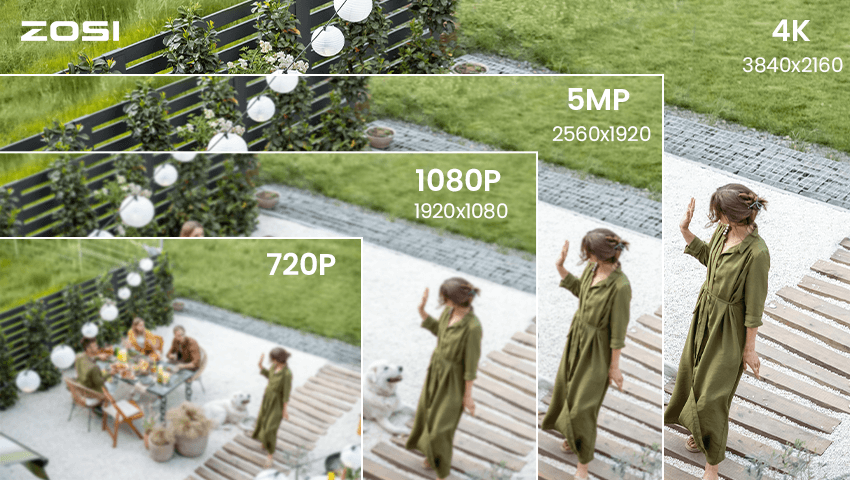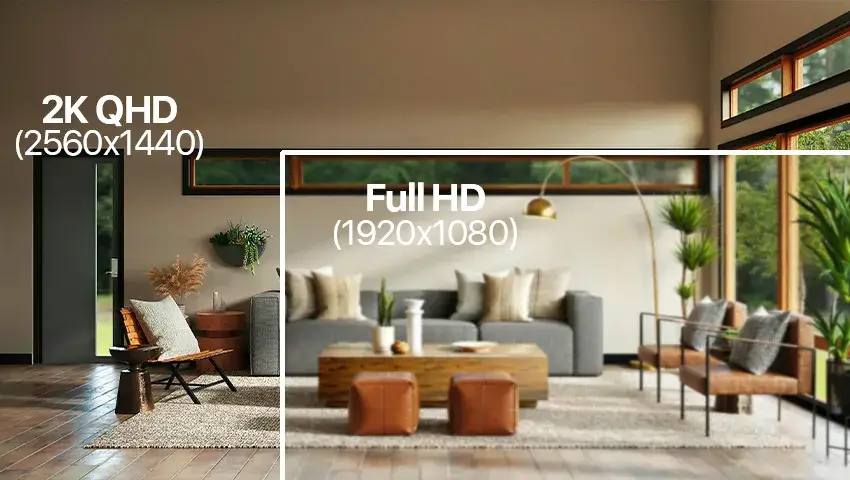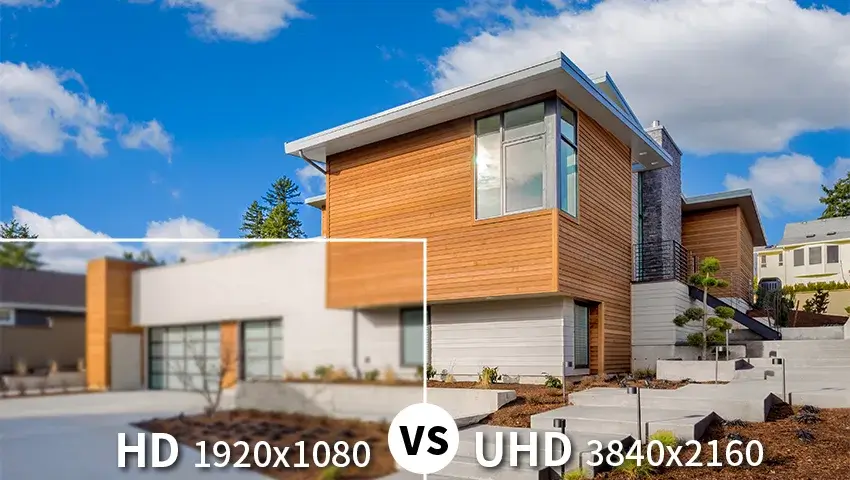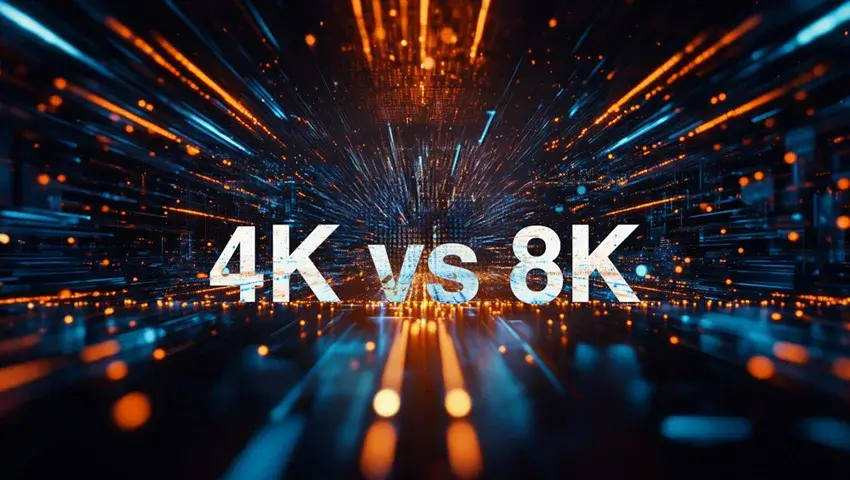Introduction
In the digital era, resolution has become one of the most discussed features when choosing TVs, monitors, smartphones, or even security cameras. With the increasing demand for home and office security, high-resolution cameras are becoming more common. Among all resolution standards, “4K” has become the mainstream choice for high-end displays and surveillance devices.
So, what does 4K resolution actually mean in terms of pixels? How does it compare to other resolutions, and how does it affect the clarity of TVs, monitors, and security cameras? Let’s break it down.
Contents
What “4K” Means
The term “4K” comes from the horizontal pixel count, roughly 4,000 pixels wide. Unlike 1080p (which emphasizes vertical resolution), 4K highlights width and image detail. This resolution is designed to deliver sharper, more detailed images, especially on large screens or in scenarios that require precise monitoring.
For example, a 4K security camera installed in a home, office, or store can clearly capture faces, license plates, or small objects, while a 1080p camera may appear blurry when zooming in.
Common 4K resolutions include:
4K UHD (Ultra High Definition): 3840 × 2160 pixels, widely used in TVs, monitors, and consumer surveillance cameras.
DCI 4K (Digital Cinema Standard): 4096 × 2160 pixels, mostly used in professional monitoring systems or high-end security setups.
Pixel Count in 4K
For 4K UHD, the total pixel count is:
3840 × 2160 = 8,294,400 pixels
This means that each frame of a display or a surveillance camera contains over 8.3 million pixels. Compared to Full HD (1920 × 1080, ~2.1 million pixels), 4K has four times the number of pixels. This high pixel density allows security cameras to maintain clarity even when zooming in on distant faces or vehicle license plates.
For DCI 4K (4096 × 2160), the pixel count is:
4096 × 2160 = 8,847,360 pixels
Slightly higher than UHD, but for most home and office monitoring applications, the difference is minimal.
Comparison with Other Resolutions
To better understand 4K’s place in displays and surveillance, here’s a quick comparison of common resolutions:
·720p (HD): 1280 × 720 → ~0.9 million pixels
·1080p (Full HD): 1920 × 1080 → ~2.07 million pixels
·5MP: 2592 × 1944 → ~5.0 million pixels
·4K UHD: 3840 × 2160 → ~8.3 million pixels
Upgrading from 720p or 1080p to 4K greatly enhances clarity, especially for identifying small details like license plates or faces. A 5MP camera falls between 1080p and 4K—offering sharper images than Full HD, but not as detailed as 4K.
Limitations and Considerations
While 4K offers clear advantages, there are practical considerations:
File Size and Storage: 4K video files are larger, requiring more storage space, which is especially important for surveillance recordings.
Hardware Requirements: 4K monitoring requires recorders and display devices that support 4K decoding; otherwise, live footage may not play smoothly.
Human Eye Limitations: On small screens, such as mobile app previews, the difference between 1080p and 4K may be negligible. However, when zooming in or monitoring long distances, 4K provides a significant advantage.
Conclusion
A standard 4K UHD resolution contains approximately 8.3 million pixels (3840 × 2160), while cinema-grade DCI 4K has slightly more at 8.84 million pixels (4096 × 2160). Compared to 720p, 1080p, or even 5MP, 4K delivers a significant leap in image detail, making it ideal for home, office, or public surveillance cameras.
Choosing a 4K security camera ensures that every frame is clear and detailed. Whether reviewing backyard footage, identifying license plates, or observing distant areas, 4K provides reliable image quality and greater peace of mind for security.
How Many Pixels in 4K Resolution?
Introduction
In the digital era, resolution has become one of the most discussed features when choosing TVs, monitors, smartphones, or even security cameras. With the increasing demand for home and office security, high-resolution cameras are becoming more common. Among all resolution standards, “4K” has become the mainstream choice for high-end displays and surveillance devices.
So, what does 4K resolution actually mean in terms of pixels? How does it compare to other resolutions, and how does it affect the clarity of TVs, monitors, and security cameras? Let’s break it down.
What “4K” Means
The term “4K” comes from the horizontal pixel count, roughly 4,000 pixels wide. Unlike 1080p (which emphasizes vertical resolution), 4K highlights width and image detail. This resolution is designed to deliver sharper, more detailed images, especially on large screens or in scenarios that require precise monitoring.
For example, a 4K security camera installed in a home, office, or store can clearly capture faces, license plates, or small objects, while a 1080p camera may appear blurry when zooming in.
Common 4K resolutions include:
4K UHD (Ultra High Definition): 3840 × 2160 pixels, widely used in TVs, monitors, and consumer surveillance cameras.
DCI 4K (Digital Cinema Standard): 4096 × 2160 pixels, mostly used in professional monitoring systems or high-end security setups.
Pixel Count in 4K
For 4K UHD, the total pixel count is:
3840 × 2160 = 8,294,400 pixels
This means that each frame of a display or a surveillance camera contains over 8.3 million pixels. Compared to Full HD (1920 × 1080, ~2.1 million pixels), 4K has four times the number of pixels. This high pixel density allows security cameras to maintain clarity even when zooming in on distant faces or vehicle license plates.
For DCI 4K (4096 × 2160), the pixel count is:
4096 × 2160 = 8,847,360 pixels
Slightly higher than UHD, but for most home and office monitoring applications, the difference is minimal.
Comparison with Other Resolutions
To better understand 4K’s place in displays and surveillance, here’s a quick comparison of common resolutions:
720p (HD): 1280 × 720 → ~0.9 million pixels
1080p (Full HD): 1920 × 1080 → ~2.07 million pixels
5MP: 2592 × 1944 → ~5.0 million pixels
4K UHD: 3840 × 2160 → ~8.3 million pixels
Upgrading from 720p or 1080p to 4K greatly enhances clarity, especially for identifying small details like license plates or faces. A 5MP camera falls between 1080p and 4K—offering sharper images than Full HD, but not as detailed as 4K.





